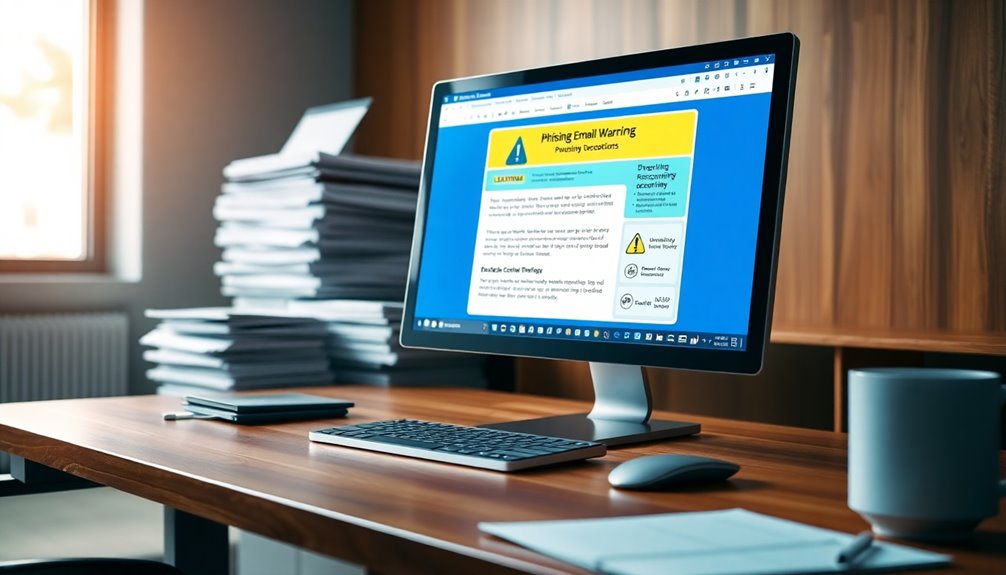To protect your team and clients from the increasing threat of phishing emails, create a clear and actionable warning template. Highlight urgent phrases, suspicious senders, and common tactics used by attackers. Encourage your employees to verify email senders and report anything unusual promptly. Provide real-life examples of past attacks to enhance understanding. Regularly update this template to keep everyone informed about new phishing strategies. Fostering a culture of cybersecurity awareness can significantly reduce risks. If you want to make your alerts even more effective, you'll find additional tips and insights that further strengthen your defenses.
Key Takeaways
- Emphasize urgent language: Alert your team to phrases like "Verify your account immediately" which are often used in phishing emails.
- Identify sender discrepancies: Encourage vigilance in checking unusual sender addresses and domains to spot potential phishing attempts.
- Highlight common traits: Share characteristics of phishing emails, such as generic greetings and misspellings, to enhance employee awareness.
- Provide actionable steps: Include instructions for verifying sender authenticity and reporting suspicious emails to promote proactive engagement.
- Foster a culture of vigilance: Regularly share phishing success stories and updates on new tactics to strengthen team awareness and communication.
Introduction

Phishing emails pose a significant threat to your personal and organizational security. With 1 in 99 emails estimated to be a phishing attack in 2023, it's crucial to enhance your phishing awareness.
The alarming 50% increase in these attacks compared to last year underscores the urgent need for effective cybersecurity training.
You need to recognize phishing attempts, which often use tactics like urgent language, impersonation of trusted contacts, and deceptive links or attachments.
These scams can lead to financial loss, data breaches, and reputational damage that could impact both you and your organization.
To combat these phishing threats, it's essential to participate in a comprehensive training program.
Regular training not only equips you with the skills to recognize and report suspicious emails but also fosters a culture of vigilance within your team.
By understanding the characteristics of phishing emails, you can better protect sensitive information and mitigate risks effectively.
Stay proactive—make sure you're well-informed and prepared to spot and report suspicious emails.
Your awareness is a vital line of defense against phishing scams that could otherwise compromise your security.
Enhances Employee Vigilance

Regularly participating in phishing awareness training significantly boosts employee vigilance against cyber threats. This training equips you with the tools to recognize and respond to phishing emails effectively, making you a crucial line of defense in protecting sensitive information.
Studies show that employees who undergo such training are 50% more likely to identify and report phishing attempts, which underscores the importance of fostering a culture of cybersecurity awareness within your organization.
By engaging in phishing awareness training, you become more adept at spotting suspicious activity and understanding evolving phishing tactics. This knowledge not only heightens your awareness but also encourages your colleagues to stay alert and proactive in reporting phishing incidents.
Given that over 90% of successful data breaches start with a phishing email, your vigilance becomes essential in mitigating these cybersecurity threats.
As you continuously update your understanding of phishing risks, you contribute significantly to a shared commitment to cybersecurity. This ongoing education ensures that you and your team remain informed and prepared, ultimately enhancing employee vigilance across the board.
Together, you can create a safer work environment and protect sensitive information from falling into the wrong hands.
Clear Call to Action

Recognizing a clear call to action in an email is vital for your protection against phishing scams. Phishing emails often contain urgent language designed to pressure you into acting quickly. Phrases like "Verify your account immediately" or "Update your payment information now" are red flags. Always scrutinize these details before taking any action.
Legitimate organizations usually address you by name, so if you see a generic greeting such as "Dear Customer," it could indicate a phishing attempt. Additionally, be wary of links that lead to websites asking for sensitive information. Instead of clicking on links, directly verify any requests for action by contacting the purported sender.
Even well-crafted phishing emails may include subtle errors, such as misspellings or incorrect logos, which can alert you to a potential scam. By fostering phishing awareness within your team, you can significantly reduce the chances of falling victim to these attacks.
Crafting Effective Phishing Alerts

Crafting effective phishing alerts is crucial for keeping your team informed and safe. Start by highlighting the specific characteristics of phishing emails, such as urgent language, unexpected attachments, and suspicious sender addresses. This helps recipients quickly identify potential threats.
Your phishing awareness emails should include real-life examples of past phishing attacks to improve employee recognition and awareness. Showcasing the tactics used by cybercriminals makes the threat more relatable.
It's important to clearly outline actionable steps for your team. Encourage them to verify the sender through alternative communication channels and to report suspicious emails to the IT department. Emphasizing that 1 in 99 emails is a phishing attack can drive home the prevalence of this issue and the need for vigilance in your organization.
Regularly update these alerts with new tactics and trends to keep your employees informed about evolving phishing strategies. By maintaining a proactive approach, you can foster a culture of awareness and preparedness, ultimately protecting your team and clients from potential phishing threats.
Pro Tips for Maximizing Impact

To maximize the impact of your phishing alerts, focus on clear communication and relatable content. Start with concise subject lines that explicitly label the email as a warning about phishing threats. This enhances immediate recognition and urgency among recipients.
Include real-world examples of phishing emails, complete with screenshots, to demonstrate common phishing tactics and make the risks feel more tangible. Encourage your team to verify sender addresses carefully and scrutinize links before clicking. With 1 in 99 emails being a phishing attempt, emphasizing this point is crucial.
You can also incorporate statistics, like the alarming 50% increase in phishing attacks in 2023 compared to 2022, to highlight the urgency of your alerts. Don't forget to provide clear action steps for reporting suspicious emails. Make sure everyone knows the protocol, fostering a proactive security culture within your organization.
Common Mistakes to Avoid

Phishing scams often thrive on common mistakes that can easily be avoided. One of the biggest pitfalls is failing to avoid clicking on links or downloading attachments from unknown or unsolicited emails. This is a common way for phishing attempts to deliver malware.
Be wary of suspicious emails that create urgency tactics, pushing you to act quickly without proper scrutiny. Attackers rely on this pressure to catch you off guard.
Always verify authenticity by double-checking email addresses for slight misspellings or unusual domains. Phishing emails often use addresses that closely resemble legitimate ones but contain subtle differences. Remember, legitimate organizations will never ask you to provide sensitive information, such as passwords or personal details, via email.
Additionally, it's crucial to regularly report suspicious emails to your IT department. Timely reporting can prevent further phishing attempts and protect sensitive information for both team members and clients.
Warning Email Template Example

Recognizing the signs of a phishing email is key to protecting yourself and your organization. A phishing email warning template should highlight clear indicators of suspicious activity, such as urgent requests for sensitive information or unexpected attachments.
These tactics are commonly used in phishing attacks, so it's crucial to stay vigilant. When you receive an email, take a moment to verify the authenticity of the sender's address. Phishing emails often use similar-looking domains to trick you.
Always avoid clicking links or downloading attachments from unsolicited emails; doing so can lead to malware infections or data breaches. Your phishing email warning template should encourage you to report suspicious emails to the IT department immediately.
This proactive approach to cybersecurity fosters a culture of awareness and vigilance. Regularly updating these phishing templates is essential, as they serve as critical tools in your security awareness training, helping you recognize and respond to evolving phishing tactics.
Final Thoughts

As phishing threats continue to escalate, it's more important than ever for you and your organization to stay informed and proactive. With statistics showing that 1 in 99 emails is a phishing attack, maintaining vigilance is crucial.
To effectively combat these threats, implement regular employee training focused on phishing awareness. This can help your team recognize phishing attempts and improve overall email security.
Equip your employees with the tools they need to identify suspicious emails—look for urgent language, misspellings, and verify the sender's authenticity. Encourage a security culture by establishing a clear reporting protocol for suspicious emails.
When employees know how to report phishing, they contribute to protecting sensitive information and enhancing the organization's cybersecurity posture.
Sharing success stories of team members who've successfully identified phishing attempts can further reinforce the importance of awareness. Such stories not only educate others but also promote a sense of community in the fight against phishing attacks.
By prioritizing these strategies, you help create a workplace where everyone feels empowered to protect the organization and its clients from phishing threats.
Stay vigilant, and together you can mitigate risks and strengthen your defenses.
Frequently Asked Questions
How Do You Warn Customers of Phishing Emails?
You can warn customers about phishing emails by educating them on recognizing suspicious messages, verifying sender addresses, avoiding unexpected requests for sensitive information, and reporting any suspicious emails immediately to enhance overall security.
How Do You Email Employees About Phishing Emails?
You should email employees with clear subject lines, highlight common phishing tactics, and encourage verification of unfamiliar requests. Remind them to report suspicious emails immediately to foster a culture of proactive cybersecurity awareness.
How to Alert Phishing Email?
To alert about phishing emails, you should encourage your team to recognize suspicious signs, like urgent language or poor grammar. Remind them to verify senders and report any doubts to your IT department promptly.
How to Write an Awareness Email?
To write an effective awareness email, craft a catchy subject line, provide clear examples, emphasize verification steps, encourage reporting suspicious emails, and invite participation in training sessions to boost your team's security skills and knowledge.
Natali – Editor in Chief (Strategy and Mastery, AI Expert) Natali, our Editor in Chief, is the driving force behind our content’s strategic direction. With a keen eye for detail and a deep understanding of market trends, Natali ensures that our content is top-notch and strategically aligned with our client’s goals. Her expertise in AI helps to seamlessly integrate advanced technology into our marketing strategies, pushing the boundaries of conventional marketing.










